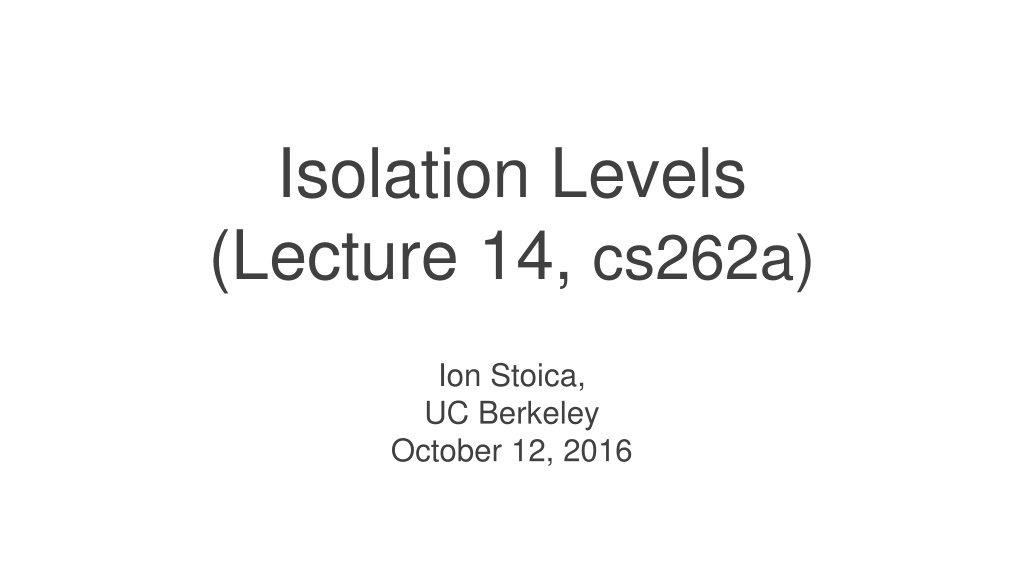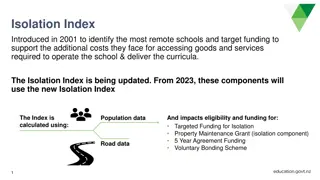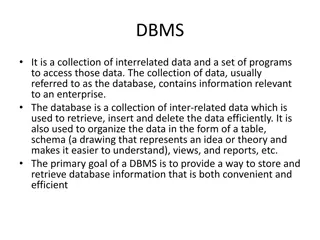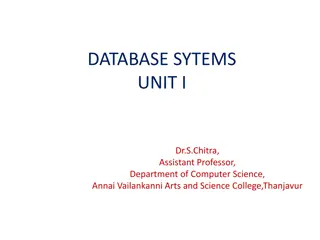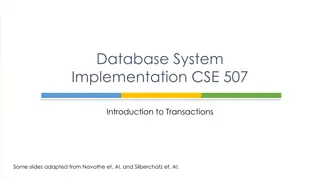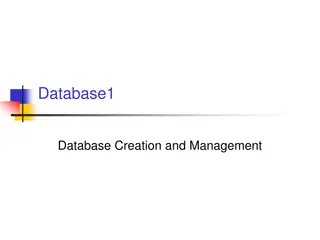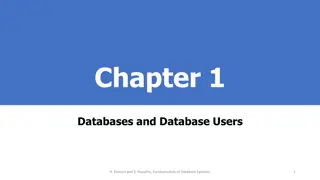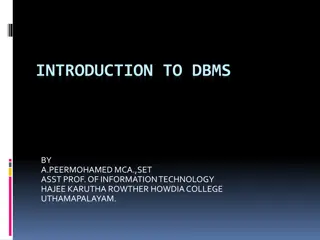Understanding Isolation Levels in Database Management Systems
Isolation levels in database management systems provide a way to balance performance and correctness by offering various levels of data isolation. These levels determine the degree to which transactions can interact with each other, addressing conflicts such as dirty reads, non-repeatable reads, and phantoms. Different phenomena are described, along with examples of how they can occur in a database system. The summary also explains the pros and cons of different isolation levels with respect to read and write operations on data items and phantom rows.
- Database Management Systems
- Isolation Levels
- Transaction Isolation
- Data Consistency
- Database Performance
Download Presentation

Please find below an Image/Link to download the presentation.
The content on the website is provided AS IS for your information and personal use only. It may not be sold, licensed, or shared on other websites without obtaining consent from the author. Download presentation by click this link. If you encounter any issues during the download, it is possible that the publisher has removed the file from their server.
E N D
Presentation Transcript
Isolation Levels (Lecture 14, cs262a) Ion Stoica, UC Berkeley October 12, 2016
Isolation Levels A feature provided by database management systems in order to increase performance when Full correctness is not necessary, or Correctness could be assured at the application level
Explicit isolation levels A transaction can be declared to have isolation properties that are less stringent than serializability However SQL standard says that default should be serializable (Gray 75 called this level 3 isolation ) In practice, most systems have weaker default level, and most transactions run at weaker levels! Isolation levels are defined with respect to data access conflicts (phenomena) they preclude
Phenomena P0: T2 writes value modified by T1 before T1 commits Transactions cannot be serialized by their writes P1 Dirty Read: T2 reads value modified by T1 before T1 commits If T1 aborts it will be as if transaction T2 read values that have never existed P2 Non-Repeatable Read: T2 reads value, after which T1 modifies it If T1 attempts to re-read value it can read another value P3 Phantom: (see next)
Phantom 1. A transaction T1 reads a set of rows that satisfy some condition 2. Another transaction T2 executes a statement that causes new rows to be added or removed from the search condition 3. If T1 repeats the read it will obtain a different set of rows.
Phantom Example T1 Select count(*) where dept = Acct // find and S-lock ( Sue , Acct , 3500) and ( Tim , Acct, 2400) T2 Insert ( Joe , Acct , 2000) // X-lock the new record Commit // release locks Select sum(salary) where dept = Acct // find and S-lock ( Sue , Acct , 3500) and ( Tim , Acct, 2400) and ( Joe , Acct , 2000)
Isolation Levels Isolation levels Degree Proscribed Proscribed Phenomena Phenomena Read locks on Read locks on data items and phantoms items and phantoms (same unless noted) (same unless noted) none none Short read locks Long data-item read locks, short phantom locks Long read locks data Write Writelocks on data locks on data items and phantoms items and phantoms (always the same) (always the same) Short write locks Long write locks Long write locks Long write locks 0 1 2 none P0 P0, P1 P0, P1, P2 READ UNCOMMITTED READ COMITTED REAPEATABLE READ SERIALIZABLE 3 P0, P1, P2, P3 Long write locks Gray s isolation degrees ANSI
Direct Serialization Graph (DSG) Conflict Name Directly write-depends Directly read-depends Directly anti-depends Description T1 writes value, then T2 overwrites it T1 writes value, then T2 reads it T1 reads value, then T2 writes it DSG T1 T2 T1 T2 T1 T2 ww wr rw Example: T1:W(A), W(B), W(C) T2: R(B), W(C) T3: W(B) R(C), W(B) wr rw wr T1 T2 T3 ww ww
Disallowing P0 Writes by T1 are not overwritten by T2 while T1 is uncommitted Simplifies recovery from aborts, e.g., T1 updates x, T2 overwrites x , and then T1 aborts The system must not restore x to T1 s pre-state However, if T2 aborts later, x must be restored to T1 s pre-state! Serializes transactions based on their writes alone all writes of T2 must be ordered before or after all writes of T1 G0 just disallows this one
G0 G0: DSG contains a directed cycle consisting entirely of write- dependency edges Just ensure serialization on writes alone More permissive than Degree 1 as allows concurrent transactions to modify same object Example: T1:W(A) W(B), T2: W(A), W(B), ww T1 T2 ww
Disallowing P1 Writes of T1 could not be read by T2 while T1 is still uncommitted It prevents a transaction T2 from committing if T2 has read the updates of a transaction that might later abort It prevents transactions from reading intermediate modifications of other transactions It serializes committed transactions based on their read/write- dependencies (but not their antidependencies), i.e., If transaction T2 depends on T1, T1 cannot depend on T2
G1 G1a Aborted reads: T2 has read a value written by an aborted transaction T1 G1b Intermediate Reads: Committed transaction T2 has read an intermediate value written by transaction T1 G1c Circular Information Flow: DSG contains a directed cycle consisting entirely of dependency edges
Disallowing P2 T1 cannot modify value read by T2 Precludes a transaction reading inconsistent data and making inconsistent updates
G2 Just prevent transactions that perform inconsistent reads or writes from committing G2 Anti-dependency Cycles: DSG contains a directed cycle with one or more anti-dependency edges G2-item Item Anti-dependency Cycles: DSG contains a directed cycle having one or more item-antidependency edges
Generalized Isolation Levels Isolation levels READ UNCOMMITTED READ COMITTED REAPEATABLE READ SERIALIZABLE G0 G0 NA Not possible Not possible Not possible G1 G1 NA Possible Not possible Not possible G2 G2- -Item Item NA Possible Not possible Not possible G2 G2 NA Possible Possible Not possible
Summary Transactions, key abstractions on databases Application defined sequence of operations on one or more databases that is atomic Key challenge: trade performance to correctness On one hand we want to interleave transactions to increase throughput On the other hand we want to isolate transactions from each other Solution: increase interleaving by providing Multi-granularity locks Relax the isolation semantics
Announcements Next Monday: Project Progress Review Create a Google doc (in addition to your proposal) specifying: Problem you are solving (this can be the same as in your project proposal if it didn t change) Design, e.g., Briefly described the alternatives you considered if more than one Architecture diagram of your system Short description of functionality provided by each component and its API Preliminary results, any No more than 3 pages
